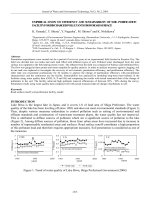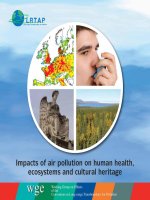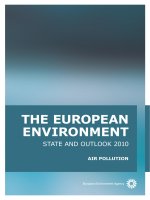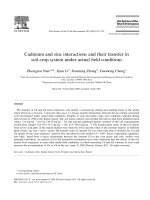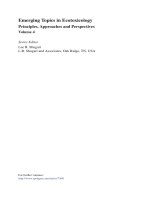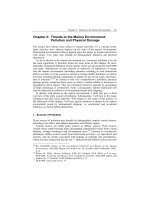- Trang chủ >>
- Khoa Học Tự Nhiên >>
- Vật lý
Human environment interactions and sustainability
Bạn đang xem bản rút gọn của tài liệu. Xem và tải ngay bản đầy đủ của tài liệu tại đây (837.55 KB, 236 trang )
Environmental Social
Science
Human–Environment
Interactions and Sustainability
Emilio F. Moran
A John Wiley & Sons, Ltd., Publication
Environmental Social Science
Environmental Social
Science
Human–Environment
Interactions and Sustainability
Emilio F. Moran
A John Wiley & Sons, Ltd., Publication
This edition first published 2010
© 2010 Emilio F. Moran
Blackwell Publishing was acquired by John Wiley & Sons in February 2007. Blackwell’s
publishing program has been merged with Wiley’s global Scientific, Technical, and Medical
business to form Wiley-Blackwell.
Registered Office
John Wiley & Sons Ltd, The Atrium, Southern Gate, Chichester, West Sussex, PO19 8SQ,
United Kingdom
Editorial Offices
350 Main Street, Malden, MA 02148-5020, USA
9600 Garsington Road, Oxford, OX4 2DQ, UK
The Atrium, Southern Gate, Chichester, West Sussex, PO19 8SQ, UK
For details of our global editorial offices, for customer services, and for information about how
to apply for permission to reuse the copyright material in this book please see our website
at www.wiley.com/wiley-blackwell.
The right of Emilio F. Moran to be identified as the author of this work has been asserted in
accordance with the UK Copyright, Designs and Patents Act 1988.
All rights reserved. No part of this publication may be reproduced, stored in a retrieval system,
or transmitted, in any form or by any means, electronic, mechanical, photocopying, recording
or otherwise, except as permitted by the UK Copyright, Designs and Patents Act 1988, without
the prior permission of the publisher.
Wiley also publishes its books in a variety of electronic formats. Some content that appears in
print may not be available in electronic books.
Designations used by companies to distinguish their products are often claimed as trademarks.
All brand names and product names used in this book are trade names, service marks, trademarks or registered trademarks of their respective owners. The publisher is not associated with
any product or vendor mentioned in this book. This publication is designed to provide accurate
and authoritative information in regard to the subject matter covered. It is sold on the understanding that the publisher is not engaged in rendering professional services. If professional
advice or other expert assistance is required, the services of a competent professional should be
sought.
Library of Congress Cataloging-in-Publication Data
Moran, Emilio F.
Environmental social science : human-environment interactions and sustainability / Emilio F.
Moran.
p. cm.
Includes bibliographical references and index.
ISBN 978-1-4051-0573-6 (hardcover : alk. paper) – ISBN 978-1-4051-0574-3 (pbk. : alk.
paper) 1. Nature–Effect of human beings on. 2. Human ecology. 3. Biotic communities.
4. Environmental degradation. 5. Sustainable living. I. Title.
GF75.M668 2010
304.2–dc22
2009039204
A catalogue record for this book is available from the British Library.
Set in 10/12pt Sabon by SPi Publisher Services, Pondicherry, India
Printed in Malaysia
01
2010
To
Elinor Ostrom, Eduardo Brondízio, and Leah vanWey
For their friendship and scholarly partnership
with me over many years
Contents
List of Illustrations
Preface
ix
xi
1 The Challenge of Human–Environment
Interactions Research
The Evolution of Social Ecological Systems
Characterization of Contemporary Global
Environmental Changes
History of the Development of the Human Dimensions Agenda
Characteristics of the Research on the Human Dimensions
The Way Forward: Integrative Science
7
16
20
22
2 Theories and Concepts from the Social Sciences
Population, Technology, and Central Place Theories
Population and Environment Theories
Agency and History
Decision-theoretic Approaches
Political Economy and Political Ecology
Cultural Ecology
25
25
31
34
37
42
46
3 Theories and Concepts from the Biological Sciences
Evolution by Natural Selection
Species Respond Individualistically, Not as Communities
Interactions with Other Species: Niche and Neutral Theories
Top-down vs. Bottom-up Control in Ecosystems
Succession
Island Biogeography
Equilibrium and Nonequilibrium Theories
Biodiversity and Ecosystem Processes/Services
The Ecosystem Concept in Biology and the Social Sciences
49
50
51
52
53
54
59
61
62
63
1
2
viii
Contents
4 Spatially Explicit Approaches
Remote Sensing and GIS
A Case Study Using GIS/Remote Sensing to Study Amazonian
Deforestation
Urban–Rural Spatial Dynamics
Modeling and GIS
70
74
77
83
88
5 Multi-scale and Multi-temporal Analysis
An Approach to Multidisciplinary, Multi-scale Research
Scale
Local Level of Analysis
Regional Level of Analysis
Global Level of Analysis
Future Directions
93
97
100
103
106
108
110
6 Biocomplexity in Ecological Systems
Introduction
Spatially Explicit Processes in Ecological and Social Systems
Agent-based Modeling of Complex Systems
Hierarchical Modeling
Conclusions
112
112
115
120
124
124
7 Environmental Decision Making
Institutional Analysis
Individual Behavior and Environmental Decisions
Decisions and Social Context
Conclusions
126
131
134
136
140
8 Towards Sustainability Science
Sustainability Science Research Priorities
Scales of Sustainability
Cities and Sustainability Science
Climate Change and Sustainability
Conclusions
143
145
149
149
153
156
References
Index
158
203
List of Illustrations
Figures
1.1
1.2
1.3
2.1
2.2
3.1
3.2
3.3
4.1
4.2
4.3
4.4
5.1
5.2
8.1
Rate of increase in several spheres of human activity
for the past 300 years
Rates of increase in several spheres of the earth system
Vostock Ice Core Record
The demographic transition
Trends in total fertility rate (1950–2000)
Theories proposed to account for successional dynamics,
following disturbance
General causes of succession and contributing processes
and modifying factors
Diagram illustrating Forest Transition Theory
Researcher taking a GPS reading in the field, Brazilian
Amazonia
Classic map from Snow, illustrating the spatial location
of cholera cases in London, 1854
Deforestation in the Brazilian Amazon, 1978 to 2007
Crop choice is affected by soil quality
Comparison of the spatial, spectral, and temporal resolution
of the main remote sensing platforms available
Method of multilevel analysis of land-use and land-cover
change
Changing pattern of temperature and precipitation for Japan
10
12
14
29
30
55
57
58
71
73
79
82
99
102
154
x
List of Illustrations
Plates
Plates fall between pages 114 and 115
Plate 1
Plate 2
Plate 3
Plate 4
Overlay of property grid on a Landsat image
for Altamira, Pará, Brazil
Study area showing cohort-based stratified sampling
in Altamira using the overlay in Plate 1
Differences in the development of side-by-side
properties in colonist farms
Comparison of the spatial resolution of Quickbird
and Landsat TM in urban area analysis
Preface
This book will synthesize the foundations for the emergence of a new
cross-disciplinary enterprise that many scholars are calling environmental
social science, and/or, human–environment interactions research (aka, sustainability science and coupled human natural systems research). The book, to
remain coherent, cannot take on every topic under this broad umbrella. Thus,
important areas in human environment research such as international environmental regulatory regimes (environmental treaties), environmental policy
formation, public environmental concern and pro-environmental behaviors
and valuation of environmental goods and services are not addressed here.
The goal, instead, is to make accessible to both natural and social scientists
the tools and the language that are used in this multidisciplinary type of work
thereby facilitating the collaborative work across the natural and social sciences. The focus is very much on spatially explicit approaches to this area of
research and how to use these approaches to bridge the divide between the
social and natural sciences. One of the impediments to multidisciplinary
research has been a lack of familiarity with the foundational theories and
methods underlying the approaches used in the social sciences and the biophysical sciences. It is my hope that this book will assist those who wish to
work across these boundaries. To do so we need to understand the underlying
assumptions and theories, and which ones have been productive in past and
current research.
In writing the book, on a topic that I have spent decades studying,
researching and analyzing, I have turned to some of my earlier writings
(particularly those from the past decade or so) and readers will find some of
the writing here reminiscent of some of these earlier writings of mine. This
is as it should be, since this book is an effort to take much of what I have
learned from cross-disciplinary research and teaching, and leverage it now
in this effort to provide a compendium of that experience as it applies
to how to facilitate the interaction of social and bio-ecological scientists.
xii
Preface
This is a continuing challenge, and one that this book will not solve.
However, it is my sincere hope that the book will provide members of the
community with resources to facilitate conversation, formulation of questions that are integrative in nature, and to result in better collaboration
between scientists. The literature on this broad range of subjects is also all
encompassing, and I have tried to be selective in providing an entry into
these subjects, rather than try to be encyclopedic.
It is probably worthwhile here to make note that there are many terms
used for this area of research which could cause confusion among those new
to the subject. Each of the social sciences has an environmental component
(i.e. environmental anthropology, environmental geography, environmental
history, environmental sociology, environmental and ecological economics,
environmental psychology), and one finds almost the same sort of detail in
the bio-ecological sciences (i.e. plant ecology, human ecology (now a section
of the Ecological Society of America), and ecosystem ecology to name just a
few). If one moves to consider interdisciplinary approaches, the problem
occurs again with names such as human ecology (which goes back to the
early years of the twentieth century, and of which there are diverse branches
such as the well-known program at Cornell University, where it referred to
Home and Consumer Economics (but largely focused on nutrition), and to
the Urban Ecology School at Chicago in the 1920s, and the physical anthropologists working on Human Biology and Adaptability). Stern (1993) has
proposed the use of the term “second environmental science” to refer to this
human environment area, and NSF has nudged the field by creating a program on “coupled human natural systems” (cf. Liu et al. 2007a, 2007b).
While each of these terms has a history, and some distinctive context from
which it came, they are mostly concerned with linking social and natural
sciences in addressing the complex problems of the environment. While
there are any number of recent edited volumes that try to introduce readers
to this subject, this book is an effort to provide a more unified perspective
wherein spatial approaches are viewed as a lingua franca or integrative
framework for this research area, and introduce both social and natural
scientists to the tasks that we must undertake to make these types of complex systems approaches move forward. Depending on the training of
instructors and what they view as missing here, it is presumed that this book
will be used in conjunction with other books and/or a diversity of articles to
provide advanced undergraduates and graduate students with the necessary
breadth and depth to become informed participants in this interdisciplinary
field of study.
I want to take this opportunity to thank the many colleagues who have for
years stimulated me with their questions, reviews, critiques, and shared their
experiences in this cross-disciplinary area. They are too numerous to mention individually. I was particularly stimulated by participation over many
Preface
xiii
years in the National Research Council Committee on the Human Dimensions
of Global Environmental Change, the Land Use and Land Cover Change
Scientific Steering Committee, the Transition Team for the Global Land
Project, and the Smithsonian’s scientific committee of the National Museum
of Natural History. The imprint from these interactions with superb scholars
engaged in the issues raised by this book was always inspiring and has moved
me to write this book. I also wish to thank the National Science Foundation
(NSF), the National Institute for Child Health and Human Development at
NIH, the National Aeronautics and Space Administration (NASA), the
National Oceanic and Atmosphere Administration (NOAA) and the Tinker
Foundation for support of my work over the years that has made possible
my engagement with these research issues – and Indiana University for
having provided a home in which I had the freedom to pursue these diverse
tasks, centered at two research centers, the Anthropological Center for
Training and Research on Global Environmental Change (ACT, www.
indiana.edu/∼act) and the Center for the Study of Institutions, Population,
and Environmental Change (CIPEC, www.indiana.edu/∼cipec). Readers will
find many resources, including downloadable PDFs at these two websites,
which complement substantively the broad ideas presented in this book.
I also want to thank my research assistants, Paula Sauer Dias, Melanie
Knapp, and Kelsey Scroggins, for their dedicated work in finding the literature and preparing the book for publication. Linda Day helped coordinate
their efforts and I also wish to thank her. I wish to thank Rosalie Robertson
and Julia Kirk, from Wiley-Blackwell, for keeping just the right amount of
gentle pressure to keep me writing even as I found myself engaged in multiple research projects that required my time as well. This book is dedicated
to Elinor Ostrom, Eduardo Brondízio and to Leah VanWey – three colleagues
with whom I have had a very productive partnership over the years (designing and writing proposals together, and then carrying out and writing up the
results), and who have proven always stimulating scholars and loyal friends.
I feel immensely grateful for having had the opportunity to work closely
with them.
Bloomington, IN
July 1, 2009
1
The Challenge of
Human–Environment
Interactions Research
During the past decade there has been rapid development of research on the
human dimensions of global environmental change. This growth has been a
result of several factors. Evidence for climate change, loss of biodiversity,
rapid deforestation in the tropics, and an impending crisis in availability of
potable water have made scholars and policy makers aware of the need to
address the causes and consequences of these global processes. Moreover, it
is widely recognized that these cumulative processes vary in their severity
from region to region, and from place to place. In order to understand these
processes, research for the past decade has supported the breakdown of
traditional disciplinary boundaries in order to understand in more systematic fashion the complexities of the current human–environment nexus.
While interdisciplinary research is nothing new, there has been considerable
progress in identifying some of the dimensions that speak to these contemporary environmental problems.
The chapter begins by examining the mounting evidence for the cumulative
nature of global environmental change, and the requirements to begin to scientifically understand it. Scientists working on this issue have come to a nearly
unanimous conclusion that we cannot begin to understand global environmental change without a concerted and unified effort that integrates both
biophysical and social sciences (NRC 1997a; NSF 2003). Human agency (i.e.
actions of individuals) is implicated in most of our current dilemmas, and must
play a part in solving them. However, integrating the social sciences and the
natural sciences has not been easy, nor has the cacophony of competing theories and paradigms helped to promote collaboration between the social sciences and the natural sciences. This chapter reviews the evidence for the nature
of the changes, considers the difficulties in understanding these complex biogeophysical and social processes, provides some history of the development of
this interdisciplinary area of study and of global environmental change, and
lays the basis for the organization of the rest of the book.
2
Human–Environment Interactions
The Evolution of Social Ecological Systems1
As a species we have relied on our capacity for sociality and communication
in order to surpass our physical limitations (Richerson 1977). Our success
as a species in spreading and colonizing the planet was through operating as
relatively small groups of hunter-gatherers (HG). HGs’ advantages were
their behavioral flexibility, based on small-group trust and reciprocity, in
response to opportunities and their highly mobile strategy of resource
harvesting. This strategy served our species well for most of our time on the
planet. However, as we grew in population size this strategy began to demonstrate its limitations in providing for an ever larger population. Huntergatherers knew about plant reproduction and carried out light management
of plants of interest to them long before they began to sedentarize and turn
into farmers (Smith 1989).
This first major transformation in social ecological systems, from huntergathering to farming, was a result of population increase, growing confrontation of HG bands over resources, and of rising costs and risks of moving
into marginal environments. It took a couple of millennia for the transformation from a mostly HG landscape to one increasingly occupied by farming
groups (i.e. in North America at least, Smith 1989). Whether famine played
a role is not clear from the archeological record. Like many other transformations in social ecological systems, it probably had the shape of the
diffusion of innovations (Rogers 1969) with a few adopting the change early,
followed by a very slow adoption by others, and finally substantive adoption
when the benefits were absolutely clear to most (and the price of nonadoption was dear). The greater density of farming communities allowed them
to occupy preferred territories, and HGs increasingly were pushed into marginal areas which could not be cultivated. The keystone features of this new
farming mode of production were the evolution of community institutions,
shifts in the scope of reciprocity and trust, domestication of plants and animals, and sedentarization. The shift in reciprocity and trust led to features of
social cooperation being associated at first with the settlement, and as settlements grew in size to kin-based groupings such as lineages, clans, and moieties. This reduced flexibility in HG systems since the common form of descent
was bilateral, meaning that individuals traced their descent from either the
paternal or maternal sides, and band membership was highly flexible.
In settled farming communities, control over land through inheritance
grew over the years. In order to ensure control over the better land, and
eventually over investments such as irrigation and homes, lineal descent
1
This section is based on an earlier discussion to be found in People and Nature (Moran
2006).
Human–Environment Interactions 3
(through either father or mother) came into play in order to provide clear
forms of inheritance, along with the development of rules of preferred
marriage, and even endogamy, to ensure control over resources. Whereas
exogamy had been preferred before, and indeed it is a preferable evolutionary strategy from a biological perspective, with the growing importance of
land, and accumulated wealth, interest in keeping wealth intact among those
already well-off favored intermarriage among favored families. This resulted
in extreme cases in caste endogamy, and class consciousness in marriage
choice. The deleterious biological impact of this strategy is well known in
the genetic aberrations found in some European royal families in the past.
The evolution towards kin-based lineal systems also provided a more
rigid form of passing on cultural values, identities, norms, and religious
preferences. This process took hundreds of years to occur as groups developed their own combination of workable ways of controlling resources as a
function of population density, competition, and resource availability.
In areas with great resource patchiness, where control over favorable patches
was key to success, the development of sophisticated forms of kin-based
control was more rapid given the stakes, whereas in areas with widely distributed resources and patches it was often easier for resource competitors
to just move elsewhere and maintain a more flexible and less restrictive set
of community rules.
Over time, as agriculture moved from extensive production systems to
more intensive systems based on irrigation and eventual mechanization, social
stratification, ethnicity, and complex rules for resource use and exclusion
came into being. Whereas in the former extensive systems it was a value to
share accumulated resources with other less fortunate members of the community, thereby acquiring social capital and prestige, in the latter the amount
of shared resources declines, prestige still goes to those capable of concentrating resources but those resources are more sporadically redistributed,
thereby increasingly rewarding those who already have more resources and
productive capacity or wealth. Control over land becomes the greatest source
of wealth, and by extension this provides greater control over labor, as more
and more people are not able to control access to land – especially in patchy
environments such as semi-arid landscapes.
Boserup (1965) and others (Netting 1968, 1981, 1993) have shown that
the most important driver of the intensification implied by the shift from
HG to agriculture has been population growth leading to greater applications of technology to production in order to stave off famine and meet the
basic needs of growing populations. It is associated with greater competition over resources and the growing need to store supplies for times of scarce
resources. The need to store provisions, rather than move to find them,
resulted in a shift in how labor was invested, and in the settlement pattern
of peoples worldwide.
4
Human–Environment Interactions
As these populations grew more numerous, chronic warfare ensued as
groups competed for the best soils and the prime spots along the river or
mountain, and sought ways to recruit more members to their communities.
In a world of hand-to-hand combat, having strong and numerous men to
field was the top determinant of success in holding onto territory. Over
time, some groups developed from single village communities into networks of communities, and chiefdoms emerged that provided some capacity
to mobilize larger social units when any of their member communities was
threatened. The evidence is quite substantial that, as human communities
grew more successful in production, the temptation was great for other
communities to take away their accumulated wealth (often in the form of
grain or animals). As in the shift from HG to extensive cultivation, the
shift from extensive cultivation to intensive cultivation appears to have
been driven by population growth putting too much pressure on resources
(Boserup 1965; Netting 1993). One study showed that a given area of
irrigated land could support 14 times as many families as it could under
shifting cultivation (Palerm 1968; Spooner 1972). However, another
explanation offered by scholars has been that this intensification was
forced upon people either by external domination and colonialism
(cf. Geertz 1963) or by internal domination brought about by elites wishing
to control land resources for their own political and military objectives
(Demarest 2004).
Associated with farming populations one often found pastoralists, occupying land unsuitable for cultivation. In some cases, they represented segments of ethnic farming populations, in other cases they represented other
ethnic groups. Pastoralist social organization shows much greater flexibility
than other forms of subsistence because of the flexible nature of managing
animals. Sometimes it is possible to gather people and animals in areas when
rain is abundant and pasture is rich, but for at least half of the year or more,
the drying of the savannas results in scattering of people and animals. This
scattering would put these populations at risk if it were not for mechanisms
such as segmentary lineages that allow segments of large lineages to call
upon others to come to their assistance in times of trouble. Thus, pastoral
societies have developed an impressive capacity to field armed men to defend
their animals and people – and then to return to a very scattered and
apparently disorganized pattern of moving to find the best forage (McCabe
2004). It is a remarkable example of social self-organization that results in
politically sophisticated outcomes. Farmers and pastoralists maintained an
uneasy truce and trade relationship over the years, and there are welldocumented cases of pastoralists becoming farmers and vice versa under
favorable conditions.
It was just a matter of time, and opportunity, for people to have their
growing villages develop into larger and more complex entities that we have
Human–Environment Interactions 5
come to call cities. Urban areas provided a site for trade, for the exchange
of information, for specialists in a large number of skills to meet the needs
of a more technologically intensive society, and for redefining the nature of
social ecological interactions. The rise of urban centers is most commonly
associated with irrigation and the rise of complex water control. As these
systems grew in size and complexity, breakdown became more common and
more costly. In time, when they had grown to pharaonic proportions, the
systems could collapse when either information or climate, or both, were
beyond the capacity of managers (Butzer 1976).
If the rise of cities and a growing network of linked villages into states
proved to be a considerable source of disturbance in social ecological interactions, imagine what happened with the rise of that technological wonder
that is the industrial revolution. Cities are symptomatic of human transformation of social ecological systems: they are creative centers where some
of the best and brightest of every society are concentrated to develop the
arts, technology, education, science, and commerce. Yet, they are also often
chaotic, with erosion of social controls, and distant enough from day-today realities of environment to ignore environmental feedbacks for a very
long time. That is because urban areas have too many layers of information between the environment and the decisions managers take – who are
motivated by many other incentives than just ensuring good environmental management: political pressures, mis-valuation of the resources, selfinterest, and corruption (see discussion of urban ecology in Moran 2007,
ch. 10).
The industrial mode of production2 is accompanied by major technical
innovations that also result in a reorganization of the division of labor
(Schnaiberg 1980). The industrial revolution’s larger environmental impact
is the product of discovering the use of fossil fuels. First, and for a very
long time, this involved only the use of coal. Oil and natural gas came
much later. In using fossil fuels humans did not have to compete with any
other animal species to use the resource, as we had often had to do with
the use of plants (herbivores) and animals (carnivores). This would seem to
be a win–win situation, and it certainly allowed for an enormous increase
in the amount of energy that humans could harness for productive purposes. Unfortunately, the exploitation of the huge amounts of fossil fuel
materials stowed away for geologic periods of time in subterrestrial sinks
and the launching of the by-products from their use into the biosphere,
kicked off biogeochemical changes in the atmosphere that took a couple of
centuries to be felt and which now threaten our planet. But these changes
were not entirely surprising. Local and regional consequences of the use of
2
Mode of production is used in the anthropological meaning of the term, rather than Marx’s
usage.
6
Human–Environment Interactions
fossil fuels were felt early on: the nineteenth century fogs of industrial
cities like London, with serious health consequences for people living in
these locations being the most recognized. While the rich could escape to
their rural estates to breathe fresh air, the poor in the cities grew sick from
the constant exposure to foul air. Social stratification, along with the use
of police and power to maintain this mode of production with its high
human and environmental costs, took place then and continues into the
present, as developing countries industrialize with similar consequences
(e.g. the current urban pollution in China’s industrial centers). The result
has been a growing loss of trust and the virtual extinction of reciprocity
except in the bosom of families, growing disparities between people in
wealth and access to resources, an increase in the amount of time spent
working, and a growing emphasis on consumption to support the productive capacity unleashed on the planet (see Moran 2006 for an extended
examination of this issue).
In short, over a period of 400 generations, or 10,000 years, the human
population has grown from a few million to more than 6 billion. This
growth has taken place quickly in recent decades, and has changed the
nature of how we deal with each other (Raven 2002). The biggest shift
has been since World War II and is connected to rising living standards and
rising consumption levels for materials and energy. This compounding of
population and consumption is recent and without precedent. Human populations do not respond in homogeneous ways to the environment, or anything else. Human society and culture is characterized by high diversity, and
in the past this has gone along with biological diversity. The number of people who live by hunting-gathering today is shrinking, and most of them are
connected to the global economy to some degree. Horticultural populations
(i.e. extensive farmers using slash-and-burn methods mostly) still constitute
significant populations in rural areas of developing countries – and among
those in developed countries who seek to return our food production system
to more organic methods. The latter is a fast and expanding movement that
questions the industrial mode of food production and seeks to return to
more organic ways to take care of the land and produce the food we need.
Pastoral peoples have been under pressure for decades to abandon their
migratory ways, but they still constitute an important component of how
grasslands are managed, despite efforts to block the routes of their movements. Intensive farming is growing ever more intensive, now including
genetic modification to a degree that has not been seen before. These shifts
in the relationship of people to the environment constitute the fundamental
questions that drive environmental social science and human–environment
interactions research. With the growing recognition of the human dimensions of contemporary global environmental change this area of study has
grown rapidly.
Human–Environment Interactions 7
Characterization of Contemporary Global
Environmental Changes3
The present condition of our planet is worrisome to those who pay close
attention to the evidence. More and more species are becoming endangered
or going extinct. Wetlands are disappearing at a rapid rate, endangering the
migration routes of birds, and the maintenance of local and even intercontinental biodiversity. Unprecedented levels of CO2 threaten our climate system, coral reefs, and the Greenland and Antarctic ice sheets. Pollution levels
in a growing number of cities can only be called toxic for human health. The
story goes on, giving cause for considerable alarm. There is very little evidence that governments are succeeding in implementing concrete strategic
policies which ensure a sustainable earth system. Everyone talks about sustainability, but fails to implement measures to reduce our downward spiral,
and we fail to even define what sustainability means or how we can begin to
get on a sustainable path.
What is not widely recognized is that we have in the past 60 years changed
nearly every aspect of our relationship with the environment. The Industrial
Revolution began some 300 years ago, and since then, the impact and the
pace of our impacts on the earth have been gradually increasing (Turner
et al. 1990). Yet, the impact in the past 300 years pales by comparison with
our impact in the past 60 years. We have no equivalent experience in our
entire history or prehistory as a species.
Burning fossil fuels results in emissions of vast amounts of carbon dioxide
and other earth-warming gases that are changing the atmosphere, the productivity of terrestrial vegetation, and are at the highest levels known over the
past 400 millennia. More nitrogen fertilizer is applied in agriculture than is
fixed naturally in all terrestrial ecosystems (Crutzen 2002). Fishing fleets have
depleted the stock of many species, removing more than 25% of the primary
production in upwelling ocean regions (Crutzen 2002), and the catches
are collapsing. Irrigation and other alterations of surface and underground
water are increasing the vulnerability of hydrologic systems and the people
that depend on these precious water sources (Crutzen 2002). Agricultural
activities have resulted in massive deforestation and alteration of land cover
at huge scales – with the amount of land devoted to agriculture increasing
fivefold over the past three centuries (Lambin and Geist 2006). In short,
human activities are so pervasive that they are capable of altering the earth
system in ways that could change the viability of the very processes upon
which human and nonhuman species depend.
3
This section is based on an earlier discussion to be found in People and Nature (Moran
2006) and Steffen et al. (2003).
8
Human–Environment Interactions
Both data and information at global scale are now abundant in alerting
us to the magnitude and seriousness of the processes we have unleashed.
This evidence tells us of exponential increase in carbon dioxide, exponential rates of ozone depletion and nitrous oxide concentrations in the atmosphere, rapid losses in tropical rainforests, increases in the frequency of
natural disasters and in the rate of species extinctions. The same can be said
for fertilizer consumption, damming of rivers, water use, paper consumption, the number of people living in cities, and the number of motor vehicles (Steffen et al. 2003). There has also been a steady increase in the last
60 years in the incidence of armed conflict worldwide (Kates and Parris
2003:8062). In 1992, one third of the world’s countries were involved in
such conflicts, and in that year 40 million refugees and displaced persons
were affected by armed conflicts (ibid). These figures do not include the
growing globalization of both terror and crime beyond state borders.
Some have described this growing conflict in terms of “the coming anarchy” and as a “clash of civilizations” (ibid.). These numbers have increased
severalfold since then.
The exponential increase in all these measurable phenomena is tied to the
increase in the human population, and to our consumption habits. Indeed,
one must think of these two factors in tandem. One Euro-American citizen
consumes 25 times the resources that one average citizen from India,
Guatemala, or other less developed countries does (Redclift 1996; Wernick
1997). While birth rates have steadily declined to replacement level or even
below in developed countries, these populations continue to impact the
earth’s resources far more than the larger populations in developing countries. Both developed countries and developing countries have a huge impact
on the environment, the former through consumption, and the latter through
population increases. Some developing countries have now succeeded in
reducing rates of growth (e.g. Brazil is now at, or below, replacement).
In all societies one sees conflicting cultural values. Europe has similar traditions to the USA in a number of regards (e.g. democratic institutions, capitalism) but it does not value individualism above the common good. This has
made it possible for Europe to accept more quickly than the US the proposed
reduction of carbon dioxide in the atmosphere to 1992 levels and thus
to support the Kyoto Protocol on the emission of greenhouse gases.
A profound rift between the more advanced nations of Western Europe and
the USA has developed over the willingness of the former to set limits on
carbon dioxide emissions, and the unwillingness of the US to do so.
(Nevertheless, we must remember that even West European countries have
had difficulty meeting the Kyoto greenhouse gas emission targets.) The use,
and misuse, of the earth’s resources is at the very center of international negotiations, the global political economy, and the fate of nations. These negotiations require an understanding of both environmental science, and social
